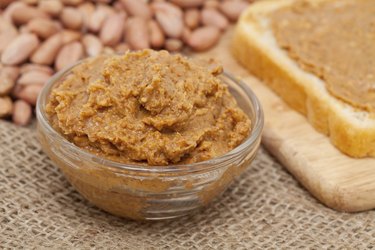
While eating peanut butter is not a treatment for high blood sugar, including natural peanut butter in a healthy diet may help lower and stabilize your overall blood sugar levels. It may also help prevent blood sugar spikes. This is good news, especially if you have diabetes or a risk of diabetes.
Natural Is Best
Video of the Day
While some commercial peanut butters contain added salt, sugar and hydrogenated oil, which is an unhealthy trans fat, natural peanut butter contains only nutrients from peanuts. It has about 13 grams of healthy unsaturated fats, 7 grams of protein, almost 2 grams of fiber and 3 grams of natural sugar in a 2-tablespoon serving size. The nutrient makeup of peanut butter may be what helps to stabilize blood sugars and prevent blood sugar spikes by slowing down and lowering your overall blood sugar levels.
Video of the Day
Blood Sugar and Appetite
Researchers of a study published in 2013 in "The British Journal of Nutrition" suggest that the synergy of the fat, protein, fiber and other carbohydrates in peanut butter is responsible for its ability to stabilize blood sugar levels. They found that 15 women with obesity and a high risk of type 2 diabetes had lower blood sugar levels and a lower desire to eat for up to 12 hours after eating a breakfast containing 3 tablespoons of peanut butter than they did when they ate the same breakfast without the peanut butter. Although this was a small study without men involved, it is promising evidence that peanut butter may contribute to a gradual decrease in your overall blood sugars both directly and by way of decreasing your appetite. When you eat smaller portions, your blood sugars tend to be lower. However, make sure you are replacing calories that you would normally consume that day, rather than adding them; weight gain is a risk for Type 2 diabetes.
Part of a Prevention Diet
Researchers from the Harvard School of Public Health suggested replacing calories you would normally consume from red or processed meats and refined grains with peanut butter. In a study published in the "Journal of the American Medical Association" in 2002 that included nearly 84,000 women, the researchers found that women who ate 5 or more tablespoons of peanut butter per week had a reduced risk of developing Type 2 diabetes.
Ideas for Including Peanut Butter
While more research is needed, both to include men and to understand the mechanism by which peanut butter can improve blood sugars, it may be beneficial for you to incorporate peanut butter into your meals and snacks. You can replace sweets and other fats with peanut butter. Have a peanut butter sandwich on whole-wheat bread instead of a roast beef sandwich, or have a tablespoon or two from the spoon instead of eating crackers or pretzels for a snack. You can also put natural peanut butter on your toast instead of butter or eat it in your oatmeal instead of sugar. Talk to your dietitian or nutritionist for more ideas about including peanut butter in your diet.
- Journal of the American Medical Association: Nut and Peanut Butter Consumption and Risk of Type 2 Diabetes in Women
- The British Journal of Nutrition: Acute and Second-Meal Effects of Peanuts on Glycaemic Response and Appetite in Obese Women With High Type 2 Diabetes Risk: A Randomised Cross-Over Clinical Trial
- The Peanut Institute: Harvard Study Shows Half Serving of Peanut Butter or Full Serving of Peanuts Eaten Daily Significantly Cuts Risk of Type 2 Diabetes
- Diabetes in Control: Peanut Butter at Breakfast Helps Control Hunger and Blood Sugar All Day
- USDA National Nutrient Database: Peanut Butter, Smooth Style, Without Salt
Is this an emergency? If you are experiencing serious medical symptoms, please see the National Library of Medicine’s list of signs you need emergency medical attention or call 911.